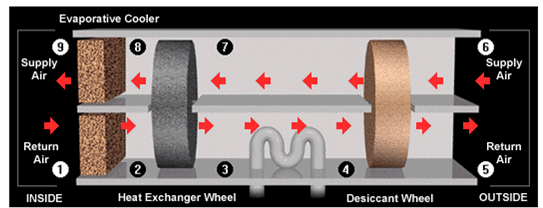SPRING 2009 - FALL 2009

A typical air conditioning system consists of a refrigerant passing through a condenser where heat is dissipated. Refrigerant vapor at low pressure enters the evaporator which absorbs heat from the surroundings. Heat is removed through the compression and condensing leading to cooling the desired environment.
The solar A/c system does not have a compression cycle which reduces energy consumption. It is also a more environmental friendly system, since no ozone layer harming refrigerants are used. Instead, water and water vapor from the air are manipulated. Outside air is processed through a desiccant wheel which removes the moisture from air. This process reduces the air’s enthalpy and wet bulb temperature. This air with a reduced relative humidity is passed through a humidification cycle that cools the air further and increases the humidity to a comfortable level. To recover the absorptive properties of the desiccant wheel, solar heated water goes through a water to air heat exchanger to dry away moisture.

